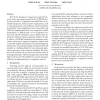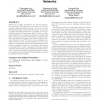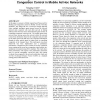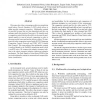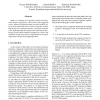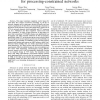ICDCSW
2005
IEEE
14 years 6 months ago
2005
IEEE
Congestion in the Internet results in wasted bandwidth and also stands in the way of guaranteeing QoS. The effect of congestion is multiplied many fold in Satellite networks, wher...
CLUSTER
2005
IEEE
14 years 6 months ago
2005
IEEE
In network protocol research a common goal is optimal bandwidth utilization, while still being network friendly. The drawback of TCP in networks with large bandwidth-delay product...
SIGCOMM
2006
ACM
14 years 6 months ago
2006
ACM
DCCP, the Datagram Congestion Control Protocol, is a new transport protocol in the TCP/UDP family that provides a congestion-controlled flow of unreliable datagrams. Delay-sensit...
IWCMC
2006
ACM
14 years 6 months ago
2006
ACM
While TCP is highly successful in the wire-line Internet, its performance fast degrades as the number of hops increases in multihop wireless networks. It is due to not only the ha...
CONEXT
2006
ACM
14 years 6 months ago
2006
ACM
In this paper, we present a Mobile Agents based Framework for Routing and Congestion control in Mobile Ad Hoc Networks (MAFRC). The framework uses a cross-layer design approach wh...
PDP
2006
IEEE
14 years 7 months ago
2006
IEEE
This paper describes a streaming architecture simulation model above Network Simulator 2 (NS2) which allows to define specific transport properties. Multimedia contents are spec...
NCA
2006
IEEE
14 years 7 months ago
2006
IEEE
Distributed Hash Tables (DHTs) provide a scalable mechanism for mapping identifiers to socket addresses. As each peer in the network can initiate lookup requests, a DHT has to pr...
LCN
2006
IEEE
14 years 7 months ago
2006
IEEE
AQM is a technique for congestion control such that a router notifies congestion to a TCP sender when congestion occurs. Almost no AQM algorithms ever take the RTT values of TCP ...
ISCC
2006
IEEE
14 years 7 months ago
2006
IEEE
Network resource management and control is a complex problem that requires robust, possibly intelligent, control methodologies to obtain satisfactory performance. While many Activ...
INFOCOM
2006
IEEE
14 years 7 months ago
2006
IEEE
— This paper examines congestion control issues for TCP flows that require in-network processing on the fly in network elements such as gateways, proxies, firewalls and even r...

